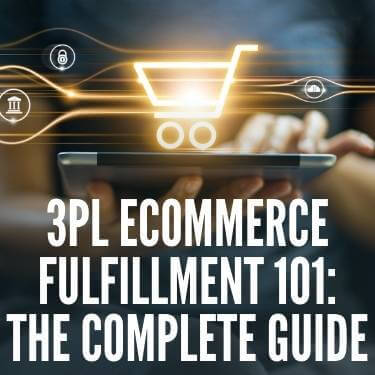
 Copy URL to Clipboard
Copy URL to Clipboard
A third-party logistics (3PL) company can be an important part to any business, especially those in the ecommerce space. But being fully knowledgeable about 3PL ecommerce fulfillment can be quite a chore if you’re not very experienced in that field. There are many different parts of the supply chain, each of which must work together seamlessly to provide your ecommerce operation the best result.
Thankfully, it’s not terribly complicated. Learning things about 3PL ecommerce fulfillment such as warehousing, pick and pack fulfillment, cross dock loading and reverse logistics will give you a leg up over the competition. These terms and more will be explained clearly throughout this article, acting as a complete guide for newcomers.
Table of Contents
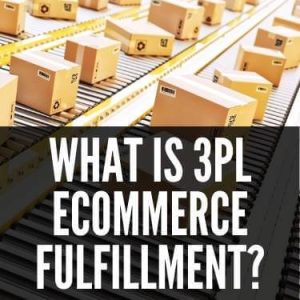
Many ecommerce operations are not huge companies where they can do each job in the line of the supply chain themselves. In fact, like any important job, there are 3PL companies that specialize in helping with ecommerce fulfillment. But what exactly is that?
3PL ecommerce fulfillment is when an ecommerce business employs the services of a 3PL to carry out certain tasks on its behalf. This can be as small as one or two parts of the supply chain or running the entire supply chain once the goods in question leave the hands of the manufacturer or wholesaler.
These tasks include but are not limited to:
Each of these services can be very important to an ecommerce business and each will be explained in further detail as the article proceeds. There are many reasons why an ecommerce outfit would choose to work with a 3PL and they are all related to making your business operate more efficiently, more cheaply or both.
For instance, a 3PL is supposed to be an expert on all matters of the supply chain since that is the main reason their own business exists. In that vein, you should look for a company that doesn’t make mistakes when filling orders, that is professional and courteous when dealing with you or your employees, is sound financially and has access to resources — whether it be technology or equipment — that make the entire process easier.
On top of being professional and courteous, the 3PL that you entrust with your valuable business assets should have the ability to help with nearly anything that would come up during normal order fulfillment. That includes processing returns or even seemingly simple things like quickly processing and responding to electronic invoicing.
In short, the better your 3PL is overall, the easier it will be to concentrate on making money from your ecommerce enterprise.
This is the very first step you’ll run into during the process of ecommerce fulfillment. Warehousing is one of the more simple concepts to grasp since it is self-explanatory.
Even if you didn’t have a 3PL fulfilling every one of your orders, if your operations are big enough, you’ll likely end up seeking out warehousing space. Whether you build your own warehouse, lease an entire warehouse or reach an agreement with a 3PL to rent out a certain amount of space in one of their facilities, you can easily see that all of your goods need to be stored somewhere.
If you choose to store your products in a 3pl warehouse, you have a few options for what is done with them once the time comes for them to be on the move again.
For the purposes of their article, the first option is the most likely in this case. So in order for a 3PL to successfully do this on your behalf, what would they need? Most sterling warehouse setups share a few key ingredients:
Speaking a little more about strategic locations, many 3PL companies have secured places in or around major shipping hubs from New York City to Los Angeles and many points in between. If the 3PL doesn’t have warehousing in multiple, well thought out spots, they may not be of much use to you.
While there may be some smaller characteristics you’re looking for, the above aspects are each important and — when combined — can be a great 3PL to partner with since they can offer you crucial components in helping your ecommerce fulfillment business succeed.
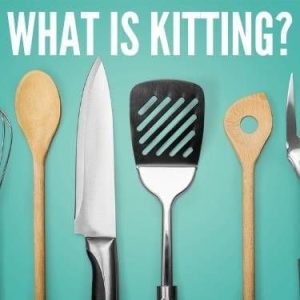
Think of kitting as a bundling of products. This is when multiple products with different Stock Keeping Units (known as SKUs) are combined into one SKU that is then sold to consumers. The kind of items that likely examples of this occurring would be things like subscription boxes, custom-ordered items or gift baskets.
Kitting is a kind of order fulfillment that is a pre-created package sent out to customers, not individual items put into a package via pick and pack order fulfillment. The reason an eCommerce business would want to use kitting for fulfillment is to cut down on the added financial obligation that comes from sending a bunch of single products to many customers or even in different orders to the same address.
Let’s use the example of a metal spatula used for grilling food outdoors. On the lower end, this might be a $10 item for a consumer. But what if the ecommerce business noticed that customers who bought the spatula would also eventually purchase a grill cleaning brush, grill tongs and skewers. So they sell those 4 items together for a total price of $30.
So you can sell a grilling tools bundle with individual tools priced attractively for shoppers. While they get a discount on a set, you will also get a break on being able to send out 3 or 4 items at once instead of shipping them out one at a time. Not only will you save on shipping, but the cost associated with 3 or 4 items having to be picked off warehouse shelves separately. Kitting can also be used in ecommerce fulfillment to help move inventory that is not selling as well.
Using another example, we can look at hand soap this time. Let’s say your apple and peach scented soaps are flying off shelves while you’re having a much harder time with your coconut and lemon scented soaps. These usually sell for $6 each but you put one of each into a bundle for $20 total. This lets you offload the less popular coconut and lemon soaps by using the more popular apple and peach with a lower overall price. And again, instead of shipping soap to four different addresses, you can clear out 4 bottles of soap to one address for a much lower price.
A standard definition of order fulfillment is the entire process from receiving an order to making sure the customer receives the order. In ecommerce order fulfillment, the specific way the customer receives its goods is when a 3PL is given the order by the business it is contracted to provide services for.
What the 3PL will do is pull the items off the shelves or a pallet in its warehouse, package it if it isn’t a kitted item and either send it via mail or a shipping service like UPS or FedEx, or load it onto one of its own trucks as freight and ship it along with other items heading to the same destination.
In this kind of order fulfillment, the business (i.e. you in this case) only has to have the product in stock in the 3PL’s warehouse and provide directions such as where to ship items or how to accept returns — which is part of reverse logistics, explained later in this article.
Another kind of order fulfillment that exists in the context of using a 3PL is called expiring order fulfillment. This is used for items that have a limited shelf life such as food or medicine. What the 3PL will do on your behalf is package the item with the shortest expiration date. The reasoning behind this is so that there is not product waste that you’ll have to eat the cost on. The customer still gets a fresh or viable product as well, so it is a true win-win.
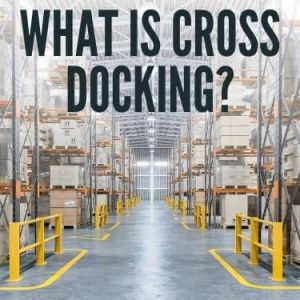
In pick and pack ecommerce fulfillment, cross docking won’t come up very often. But it’s not a bad thing to know about in case of one specific situation that can occur sometimes in the business world.
First off, cross docking is where your products will pass through a warehouse or distribution center by being offloaded of one inbound truck and loaded onto another truck in an outbound dock. The outbound truck then goes directly to a retailer or the customer. It is handled minimally with little to no storage.
In ecommerce fulfillment, you won’t need cross docking day to day. Where it can come into play is if you receive a large order from a customer that needs to be in the same shipment, like a pallet or more worth of merchandise. Instead of trying to pack those shipment into individual boxes and mail them to the customer, it could be much easier and more cost efficient to simply have the 3PL company include it on a truck already bound for the customer’s general area and have it drop shipped there. Utilizing cross docking services certainly has a host of benefits in terms of efficiency and cost that should be strongly considered.
Let’s face it: any business that sells goods must prepare for the inevitability of consumers needing to return items. And you might think that because you’re allowing a 3PL company to handle the shipping, you have no way to implement this. But any forward-thinking 3PL provider has already thought about this and has a system in place to provide this service.
Reverse logistics in the most simplest sense is about product returns. In a more complicated aspect though, it is also about how these returned products are repurposed once they make their way back. There are two things that can be done with items that are returned: the products must be disposed of if they are unusable or they can have their value recaptured, either by being reconditioned/repaired for sale or stripped of usable components to use in the manufacturing of new products.
That is a specific view of what reverse logistics is, but widening the scope one more time, the term refers to anything in which a good has to come back to the manufacturer or business after having already reached its final destination, whether that be a customer’s home or a brick-and-mortar store. In 2020, the estimated financial impact to all U.S. businesses is $550 billion when it comes to returned deliveries. Also, about 20 percent of all e-commerce purchases get returned, compared to just 10 percent of items from retail stores.
This shows reverse logistics to be an important area where streamlined efficiencies are crucial to not letting returns overwhelm your operations or negatively impact your bottom line. The recovery portion of reverse logistics is especially important to businesses since it serves two important purposes — it helps the company still profit off products that weren’t perfect in the first place and it can also reduce the environmental impact of just telling customers to throw a bad item out and sending them a new one.
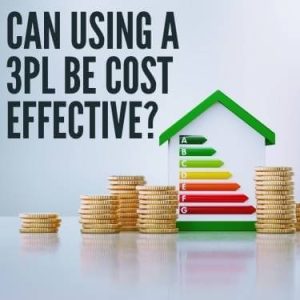
When analyzing whether a 3PL would be too high cost to use — especially if you’re just starting out selling via an ecommerce platform — it can be tempting to automatically think it will be. However, for many reasons, utilizing a 3PL for your ecommerce fulfillment can actually save your business money in a variety of ways.
First off is a much cheaper initial investment. A 3PL has warehousing space, a warehouse management system (WMS) and warehouse equipment to move items around quickly and effectively. For an ecommerce business to get set up with all that stuff would be a sizable upfront investment of both time and resources. Or you can go with a 3PL who already has everything needed.
Furthering the point of initial investment is you don’t have to staff part of a warehouse to process orders. That’s no small point, since many businesses’ biggest cost is labor. Also, you pay a 3PL based on the volume of orders it processes for you; this means the cost can vary in your favor instead of having fixed costs no matter how many of your items are handled.
Another area to consider is the ability to get your products closer to your customers before they ever order it. By partnering with a 3PL, you should have access to their network of warehouses. This will allow you to have your products strategically placed to cut down on shipping time — making your items more attractive to prospective buyers — and also shipping costs, since the items don’t have to travel as far.
Also during busier holiday seasons, where some types of ecommerce businesses can see huge jumps in order volume, a skilled 3PL is ready to take this on for you. But would you be ready to have to hire more staff or the increased costs while ramping up?
Now that you’ve read the complete guide to 3PL ecommerce fulfillment, you know how important it is to have an outstanding company to team up with. In that vein, let R+L Global Logistics be the partner that can fulfill all of your supply chain needs, which includes order fulfillment.
With our strategically placed warehouses all over the U.S., storing your products in convenient places is no problem for us. Then, depending on your needs, we can freight ship them to brick-and-mortar retailers or undergo order fulfillment on your behalf to meet whatever your business goals may be. Order fulfillment, with our years of knowledge and streamlined processes couldn’t be easier.
But R+L Global Logistics doesn’t just do order fulfillment. We excel in all areas of the supply chain, which includes:
So when you need the best in 3PL ecommerce fulfillment, give R+L Global Logistics a call today at 866-989-3082 to receive a free quote and see exactly how we can help out.
